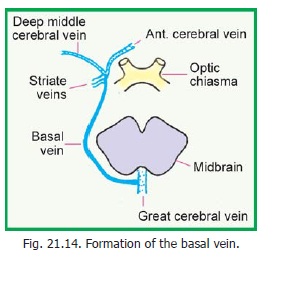Chapter: Human Neuroanatomy(Fundamental and Clinical): Blood Supply of Central Nervous System
Blood-Brain Barrier
BLOOD-BRAIN BARRIER
It has been observed that while some substances canpass from the blood into the brain with ease, others areprevented from doing so. This has given rise to theconcept of a selective barrier between blood and the brain.
Anatomically, the structures that could constitute thebarrier are as follows.
(a) Capillary endothelium.
(b) Basement membrane of the endothelium.
(c) Closely applied to the vessels there are numerousprocesses of astrocytes. It has been estimated that theseprocesses cover about eighty five percent of the capillarysurface.
Some areas of the brain (and related structures) appear to be devoid of a blood-brain barrier. These include the pineal body, the hypophysis cerebri, the choroid plexus, the median eminence (hypothalamus) and some specialised areas of ependyma in the walls of the third and fourth ventricles.
Clinical:
The blood brain barrier can break down following ischaemia or infection in the brain. The barrier can also break down in trauma and through the action of toxins. Some drugs, including some antibiotics, pass through the barrier but some others cannot.
In infants bilirubin can pass through the barrier. There is danger of encephalitis if bilirubin levels are high (seen as jaundice in the newborn or kernicterus).
(d).Traditionally it has been taught that the subarachnoid space is continuous with perivascular spaces (present around blood vessels passing into the brain). However, it has now been shown that the perivascular spaces, and the subpial space, are completely cut off from the subarachnoid space by pia mater (which is reflected onto arteries as a sleeve). The pia mater, therefore, contributes to the establishment of the blood brain barrier.

Related Topics